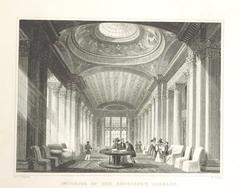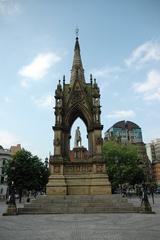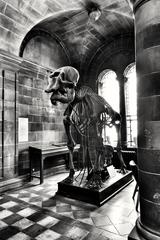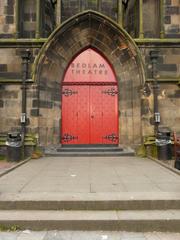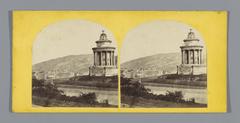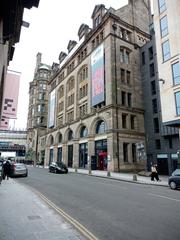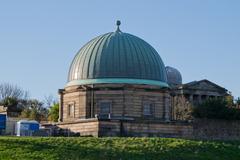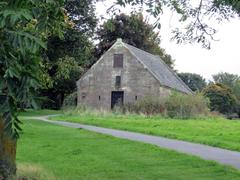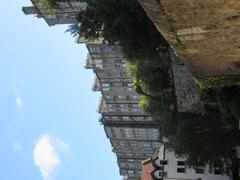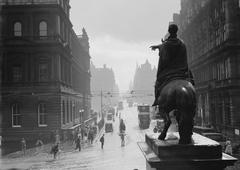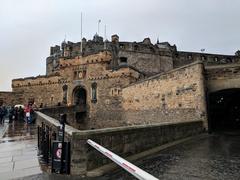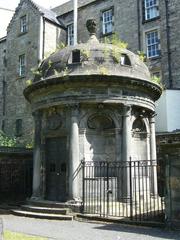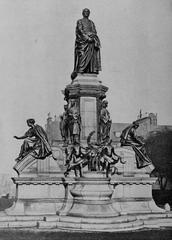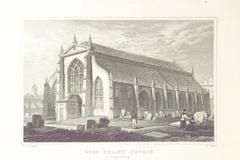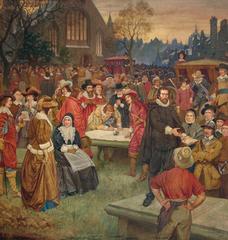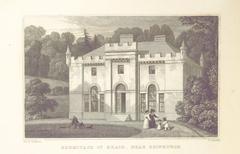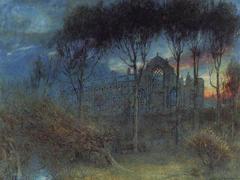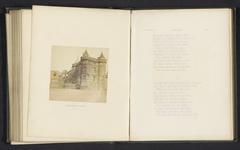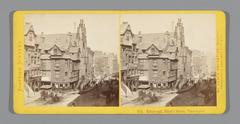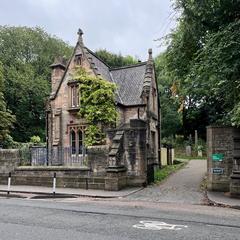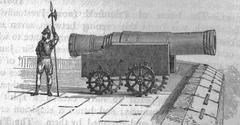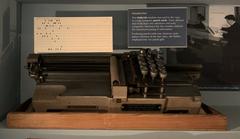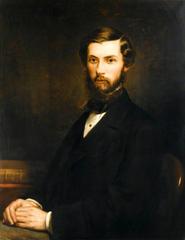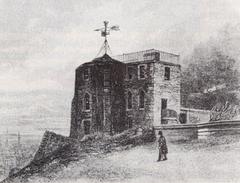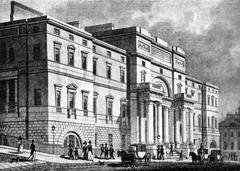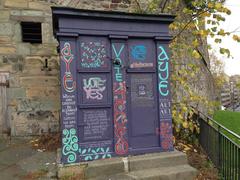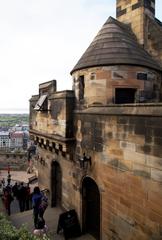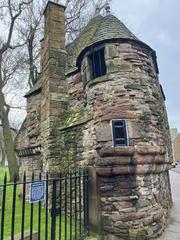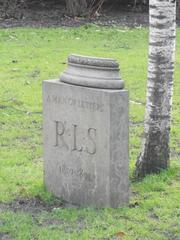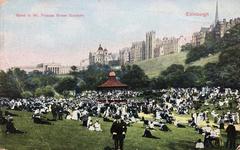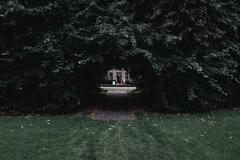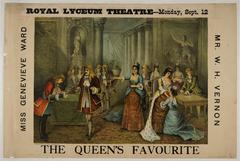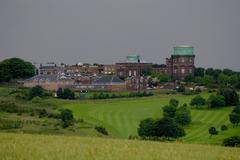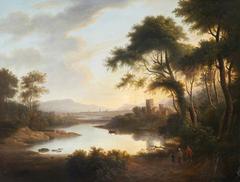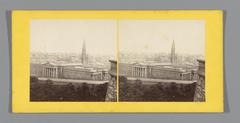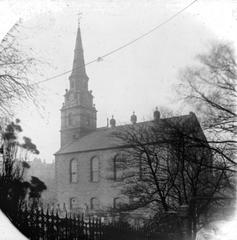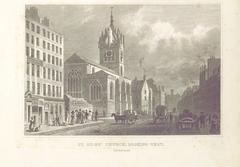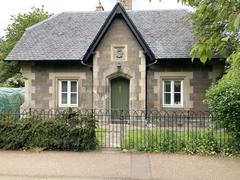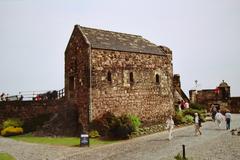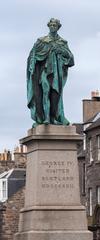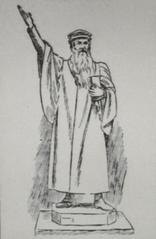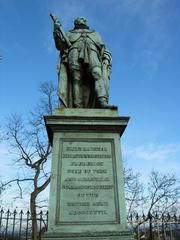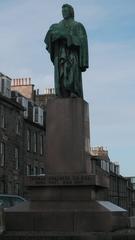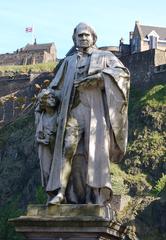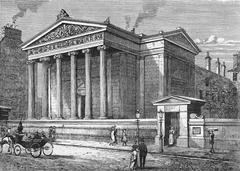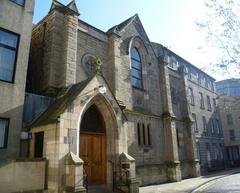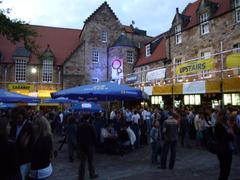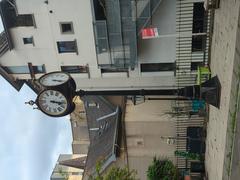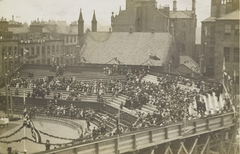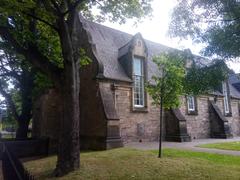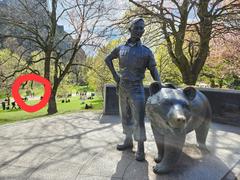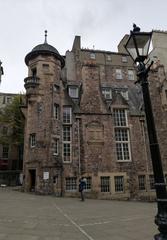Visiting Witches’ Well: Hours, Tickets, and Historical Significance in Edinburgh
Publication Date: 17/08/2024
Introduction to Witches’ Well
The Witches’ Well in Edinburgh, United Kingdom, serves as a solemn reminder of one of the most harrowing chapters in Scottish history: the witch trials and executions that spanned from the 15th to the 18th centuries. Located at the lower end of the Castle Esplanade, just below the iconic Edinburgh Castle, this monument commemorates the tragic fate of over 300 women who were accused of witchcraft and faced brutal trials and executions on Castlehill (Explorial).
The well itself, designed by John Duncan and commissioned by Sir Patrick Geddes in 1894, features intricate bronze reliefs rich in symbolism and serves as a poignant tribute to those who suffered under the paranoia and fear that gripped Scotland during this dark period (Wikipedia). Approximately 4,000 individuals were executed for witchcraft across Scotland, with a significant proportion of these trials occurring in Edinburgh (Explorial).
For modern visitors, the Witches’ Well offers a unique opportunity to reflect on past injustices while exploring one of Edinburgh’s most historically rich areas. Whether you’re a history enthusiast or a casual traveler, understanding the significance of the Witches’ Well can greatly enrich your experience in Edinburgh.
Contents Overview
- Historical Background
- Origins and Early History
- Witch Hunts in Scotland
- The Castlehill Reservoir
- Design and Commissioning
- Plaque and Inscription
- Calls for a New Memorial
- The Broader Context of Witch Trials
- Methods of Execution
- The Last Prosecution
- Modern-Day Significance
- Visiting Information
- Visiting Hours
- Tickets
- Location
- Nearby Attractions
- Accessibility
- Cultural Significance
- Conclusion
- FAQs
Historical Background
Origins and Early History
The Witches’ Well in Edinburgh is a poignant reminder of Scotland’s dark history of witch trials and executions. The well is located at the lower end of the Castle Esplanade, below Edinburgh Castle, and is the only monument of its kind in the city. It commemorates the tragic fate of over 300 women who were accused of witchcraft, put on trial, and executed at Castlehill from the early 15th century until the late 18th century (Explorial).
Witch Hunts in Scotland
During the high point of witch hunting in the early modern period, approximately 32% of accused witches came from the Lothian area, which includes Edinburgh (Wikipedia). The witch hunts were fueled by a combination of religious upheavals, political instability, and social changes, leading to widespread paranoia and fear of witchcraft throughout Europe. In Scotland, around 4,000 people were executed for witchcraft between the 16th and 18th centuries, with many trials taking place on Castlehill (Explorial).
The Castlehill Reservoir
The building upon which the Witches’ Well is affixed was originally constructed in 1851 for the Castlehill Reservoir. This building replaced a 17th-century predecessor, which was built following an act of parliament in 1624 that enabled the bringing of fresh water into the city from the nearby Pentland Hills (Wikipedia). The reservoir was connected to 12 wells around the city in 1674 and remained operational until it closed in 1992. It was later converted into the Tartan Weaving Mill in 1996 (Wikipedia).
Design and Commissioning
The Witches’ Well was commissioned by Sir Patrick Geddes in 1894 and designed by his friend John Duncan. The bronze relief features a foxglove plant, a snake curled around the heads of Hygeia, the Greek goddess of good health, and her father Aesculapius, the god of medicine (Wikipedia). Other elements of the well include trees, healing hands, and the evil eye. The water spout, now dry, is located beneath the snake’s head. The Roman numerals for the years 1479 and 1722 are inscribed on the well, marking the period during which most witches were persecuted in Scotland (Wikipedia).
Plaque and Inscription
The plaque above the fountain was mounted on the wall in 1912. The inscription reads:
“This fountain, designed by John Duncan, R.S.A. is near the site on which many witches were burned at the stake. The wicked head and serene head signify that some used their exceptional knowledge for evil purposes while others were misunderstood and wished their kind nothing but good. The serpent has the dual significance of evil and wisdom. The foxglove spray further emphasizes the dual purpose of many common objects” (Wikipedia).
The inscription has been criticized for its historical inaccuracy, particularly the assumption that those killed had magical powers (Wikipedia).
Calls for a New Memorial
There have been repeated calls for a newer, permanent memorial to those accused of witchcraft. In 2016, Edinburgh World Heritage called for a new memorial for Edinburgh, and in 2017, Dr. Julian Goodare of the University of Edinburgh and Professor Lynn Abrams of the University of Glasgow called for a new memorial for Scotland (Wikipedia). These calls were reiterated in 2019 by Dr. Goodare and Louise Yeomans, directors of the Survey of Scottish Witchcraft (Wikipedia).
The Broader Context of Witch Trials
The majority of those accused of witchcraft in Scotland—around 85%—were women. Contrary to popular belief, these women did not resemble the stereotypical Halloween witch of the 21st century, nor were they overly poor or destitute. They were usually servants to landed families or the wives of artisans and tenant farmers from rural villages across the Lowlands (National Trust for Scotland). For instance, Isobel Gowdie from Nairnshire, one of the most well-known Scottish accused witches, was the wife of a tenant farmer. Another example is Bessie Weir, one of the so-called witches of Pollok, who was the wife of a weaver from Paisley (National Trust for Scotland).
Methods of Execution
The methods of execution for those accused of witchcraft were brutal. Many were burned at the stake, while others were hanged. One particularly cruel method involved binding the accused’s hands and feet and throwing them into the Nor’ Loch (the present-day location of Waverley Station and Princes Street Gardens). If they drowned, they were deemed innocent; if they survived, they were ‘proven’ to be witches and subsequently killed (Culture Trip).
The Last Prosecution
The last prosecution for witchcraft in Scotland occurred in 1727 in Dornoch, where Janet Horne was the last person in the British Isles to be executed for witchcraft. Her daughter, however, managed to escape. The British Parliament repealed the Scottish Witchcraft Act of 1563 in 1736, along with the equivalent witchcraft act in England (Edinburgh Guide).
Modern-Day Significance
Today, the Witches’ Well serves as a reminder of Edinburgh’s darker days and stands as a testament to how far society has come in terms of understanding and tolerance. It encourages visitors to reflect upon their own attitudes towards fear and prejudice while paying homage to those wrongfully accused so many years ago (Explorial).
Visiting Information
- Visiting Hours: The Witches’ Well can be visited at any time of the day as it is located outdoors.
- Tickets: There is no admission fee to visit the Witches’ Well.
- Location: Found at the lower end of the Castle Esplanade, below Edinburgh Castle.
- Nearby Attractions: While visiting the Witches’ Well, you can also explore nearby attractions such as Edinburgh Castle, the Royal Mile, and Princes Street Gardens.
- Accessibility: The site is accessible to visitors with mobility issues, though the surrounding area can be uneven.
Conclusion
The Witches’ Well is a powerful historical monument that encapsulates a turbulent period in Scotland’s history. By understanding its background and significance, visitors can gain a deeper appreciation for this unique site. Whether you are a history enthusiast or a casual traveler, visiting the Witches’ Well offers a chance to reflect on past injustices and the progress society has made. Don’t forget to explore the nearby attractions and immerse yourself in the rich history of Edinburgh.
FAQs
- What are the Witches’ Well visiting hours? The Witches’ Well can be visited at any time as it is located outdoors.
- Do I need tickets to visit the Witches’ Well? No, there is no admission fee to visit the Witches’ Well.
- Where is the Witches’ Well located? It is located at the lower end of the Castle Esplanade, below Edinburgh Castle.
- Are there any nearby attractions? Yes, nearby attractions include Edinburgh Castle, the Royal Mile, and Princes Street Gardens.
- Is the Witches’ Well accessible? Yes, the site is accessible, but the surrounding area may be uneven.
Sources and Further Reading
- Wikipedia contributors. (2023). Witches’ Well, Edinburgh. Wikipedia, The Free Encyclopedia. Wikipedia.
- National Trust for Scotland. (2023). The Myths of Witches. National Trust for Scotland.
- Explorial. (2023). Edinburgh: The Witches’ Well. Explorial.
- Edinburgh Guide. (2023). Witches’ Well. Edinburgh Guide.
- Culture Trip. (2023). The Haunting Story Behind the Witches’ Well in Edinburgh. Culture Trip.

